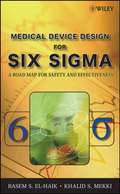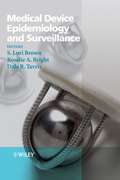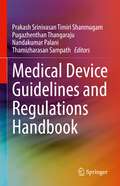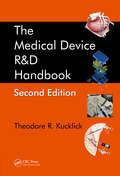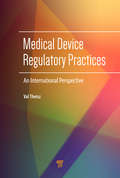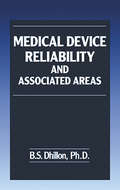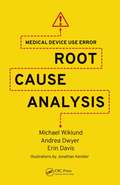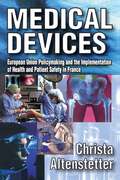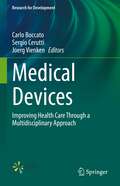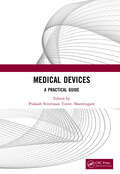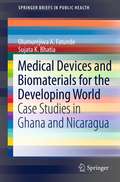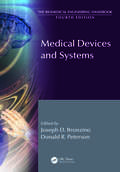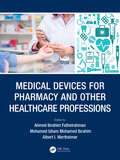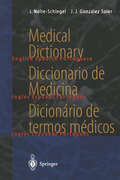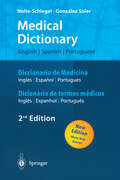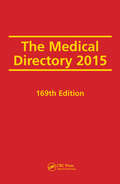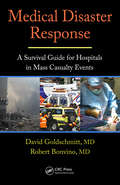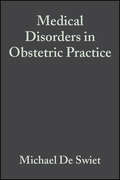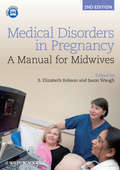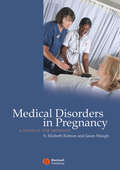- Table View
- List View
Medical Device Design for Six Sigma: A Road Map for Safety and Effectiveness
by Basem El-Haik Khalid S. MekkiThe first comprehensive guide to the integration of Design for Six Sigma principles in the medical devices development cycle Medical Device Design for Six Sigma: A Road Map for Safety and Effectiveness presents the complete body of knowledge for Design for Six Sigma (DFSS), as outlined by American Society for Quality, and details how to integrate appropriate design methodologies up front in the design process. DFSS helps companies shorten lead times, cut development and manufacturing costs, lower total life-cycle cost, and improve the quality of the medical devices. Comprehensive and complete with real-world examples, this guide: Integrates concept and design methods such as Pugh Controlled Convergence approach, QFD methodology, parameter optimization techniques like Design of Experiment (DOE), Taguchi Robust Design method, Failure Mode and Effects Analysis (FMEA), Design for X, Multi-Level Hierarchical Design methodology, and Response Surface methodology Covers contemporary and emerging design methods, including Axiomatic Design Principles, Theory of Inventive Problem Solving (TRIZ), and Tolerance Design Provides a detailed, step-by-step implementation process for each DFSS tool included Covers the structural, organizational, and technical deployment of DFSS within the medical device industry Includes a DFSS case study describing the development of a new device Presents a global prospective of medical device regulations Providing both a road map and a toolbox, this is a hands-on reference for medical device product development practitioners, product/service development engineers and architects, DFSS and Six Sigma trainees and trainers, middle management, engineering team leaders, quality engineers and quality consultants, and graduate students in biomedical engineering.
Medical Device Design for Six Sigma: A Road Map for Safety and Effectiveness
by Basem El-Haik Khalid S. MekkiThe first comprehensive guide to the integration of Design for Six Sigma principles in the medical devices development cycle Medical Device Design for Six Sigma: A Road Map for Safety and Effectiveness presents the complete body of knowledge for Design for Six Sigma (DFSS), as outlined by American Society for Quality, and details how to integrate appropriate design methodologies up front in the design process. DFSS helps companies shorten lead times, cut development and manufacturing costs, lower total life-cycle cost, and improve the quality of the medical devices. Comprehensive and complete with real-world examples, this guide: Integrates concept and design methods such as Pugh Controlled Convergence approach, QFD methodology, parameter optimization techniques like Design of Experiment (DOE), Taguchi Robust Design method, Failure Mode and Effects Analysis (FMEA), Design for X, Multi-Level Hierarchical Design methodology, and Response Surface methodology Covers contemporary and emerging design methods, including Axiomatic Design Principles, Theory of Inventive Problem Solving (TRIZ), and Tolerance Design Provides a detailed, step-by-step implementation process for each DFSS tool included Covers the structural, organizational, and technical deployment of DFSS within the medical device industry Includes a DFSS case study describing the development of a new device Presents a global prospective of medical device regulations Providing both a road map and a toolbox, this is a hands-on reference for medical device product development practitioners, product/service development engineers and architects, DFSS and Six Sigma trainees and trainers, middle management, engineering team leaders, quality engineers and quality consultants, and graduate students in biomedical engineering.
Medical Device Epidemiology and Surveillance
by S. Lori Brown Roselie A. Bright Dale R. TavrisMedical devices are crucial in medical care today and device technology advances at a dizzying pace. Medical Device Epidemiology and Surveillance is the first book to provide an overview of medical device epidemiology and surveillance as well as perspectives from regulatory agencies, the medical device industry, the health insurance industry and academia. The book is edited by experts from the US Food and Drug Administration with contributions from experienced specialists working in this field in the US and around the world. It features chapters describing broad themes in medical device epidemiology and surveillance, as well as chapters that describe specific medical devices. Medical Device Epidemiology and Surveillance is an essential reference for epidemiologists, pharmacoepidemiologists, academics, graduate students, and everybody working in the medical device industry.
Medical Device Guidelines and Regulations Handbook
by Prakash Srinivasan Timiri Shanmugam Pugazhenthan Thangaraju Nandakumar Palani Thamizharasan SampathThis comprehensive resource features in-depth discussions of important guidelines and regulations needed to understand and properly meet medical device code-related requirements. Focusing on the practical application of the regulations, the Medical Device Guidelines and Regulations Handbook delivers clear explanations, real-world examples, and annotation on the applicable provisions that will allow you to safely and confidently choose materials and processes for medical device development, testing, and manufacturing. A critical resource for researchers and professionals in the medical device field;Thoroughly covers ISO 10993, ISO 22442, ISO 14971, ISO 13485, ISO 21534, REACH, RoHS, CLP, EU MDR;Presents simplified guidelines and regulation points.
The Medical Device R&D Handbook
by Theodore R. KucklickExploring the practical, entrepreneurial, and historical aspects of medical device development, this second edition of The Medical Device R&D Handbook provides a how-to guide for medical device product development. The book offers knowledge of practical skills such as prototyping, plastics selection, and catheter construction, allowing designer
Medical Device Regulatory Practices: An International Perspective
by Val TheiszThis book is intended to serve as a reference for professionals in the medical device industry, particularly those seeking to learn from practical examples and case studies. Medical devices, like pharmaceuticals, are highly regulated, and the bar is raised constantly as patients and consumers expect the best-quality healthcare and safe and effectiv
Medical Device Reliability and Associated Areas
by B.S. DhillonAlthough Reliability Engineering can trace its roots back to World War II, its application to medical devices is relatively recent, and its treatment in the published literature has been quite limited. With the medical device industry among the fastest growing segments of the US economy, it is vital that the engineering, biomedical, manufacturing,
Medical Device Use Error: Root Cause Analysis
by Michael Wiklund Andrea Dwyer Erin DavisMedical Device Use Error: Root Cause Analysis offers practical guidance on how to methodically discover and explain the root cause of a use error-a mistake-that occurs when someone uses a medical device. Covering medical devices used in the home and those used in clinical environments, the book presents informative case studies about the use errors
Medical Devices: European Union Policymaking and the Implementation of Health and Patient Safety in France
by Christa AltenstetterMedical devices are the bread and butter from which health care and clinical research are derived. Such devices are used for patient care, genetic testing, clinical trials, and experimental clinical investigations. Without medical devices, there is no clinical research or patient care. Without life-adjusting devices, there are no medical procedures or surgery. Without life-saving and life-maintaining devices, there is no improvement in well-being and quality of life. Without innovative medical devices and experimentation, there can be no medical progress or patient safety. Medical devices and medical technology are used to create or support many different products and medical-surgical procedures. This volume on the regulation of medical devices in the European Union, with a focus on France, tackles a topic of interdisciplinary interest and significance for policymakers in countries around the globe. The EU regulatory regime is one of three global regional regimes, and medical products manufactured in EU countries are sold worldwide. As countries confront an aging population on a global scale, with associated increases in chronic diseases, physical handicaps, and multi-morbidity, there will inevitably be an increase in the demand for health services and, concomitantly, the use of medical devices in medical and surgical procedures. This will be the case regardless of whether services are delivered in hospitals, doctors' offices, or at home. The associated risks of a particular device will be the same whatever the country of origin for the device, or where the need occurs. Revolutionary medical advances increase diagnostic capabilities, but they increase the potential of harm and risks to patients. Medical technologies and devices are used ethically most of the time; yet they have the potential for unethical use when scientific medicine is elevated over human life and death. Assumptions that are taken for granted can be dangerous to a patient's health. That is why our understanding of appropriate and effective regulation of medical devices is significant to all people on all continents.
Medical Devices: European Union Policymaking and the Implementation of Health and Patient Safety in France
by Christa AltenstetterMedical devices are the bread and butter from which health care and clinical research are derived. Such devices are used for patient care, genetic testing, clinical trials, and experimental clinical investigations. Without medical devices, there is no clinical research or patient care. Without life-adjusting devices, there are no medical procedures or surgery. Without life-saving and life-maintaining devices, there is no improvement in well-being and quality of life. Without innovative medical devices and experimentation, there can be no medical progress or patient safety. Medical devices and medical technology are used to create or support many different products and medical-surgical procedures. This volume on the regulation of medical devices in the European Union, with a focus on France, tackles a topic of interdisciplinary interest and significance for policymakers in countries around the globe. The EU regulatory regime is one of three global regional regimes, and medical products manufactured in EU countries are sold worldwide. As countries confront an aging population on a global scale, with associated increases in chronic diseases, physical handicaps, and multi-morbidity, there will inevitably be an increase in the demand for health services and, concomitantly, the use of medical devices in medical and surgical procedures. This will be the case regardless of whether services are delivered in hospitals, doctors' offices, or at home. The associated risks of a particular device will be the same whatever the country of origin for the device, or where the need occurs. Revolutionary medical advances increase diagnostic capabilities, but they increase the potential of harm and risks to patients. Medical technologies and devices are used ethically most of the time; yet they have the potential for unethical use when scientific medicine is elevated over human life and death. Assumptions that are taken for granted can be dangerous to a patient's health. That is why our understanding of appropriate and effective regulation of medical devices is significant to all people on all continents.
Medical Devices: Improving Health Care Through a Multidisciplinary Approach (Research for Development)
by Sergio Cerutti Carlo Boccato Joerg VienkenThis book provides caregivers and administrators with high-quality support for strategic decision making in the selection and use of medical devices so as to ensure value optimization. Medical treatment is increasingly complex, with wide application of medical devices and corresponding involvement of physics and engineering. A multidisciplinary methodology that brings together expertise from key disciplines in a holistic, system-oriented approach is essential in controlling this complexity and further improving health care. This book will help readers to understand the design, validation, and application of medical devices and the standards and regulations that apply to them across the world. In addition, it provides technical, operational, and economic perspectives on their use. The relevance of concepts such as expenditure optimization and sustainability to medical device technology is explained and healthcare reimbursement systems are discussed from different points of view. Readers will gain a clear appreciation of the managerial and economic implications of the use of medical devices and how to get the most out of them. Academic research, industrial experiences, and case studies are presented as appropriate.
Medical Devices: A Practical Guide (Crc Press Focus Shortform Book Program Ser.)
by Prakash Srinivasan Timiri ShanmugamAn overview of the wide variety of medical devices that are an integral part of clinical practice, this practical book includes descriptions of medical devices by both clinical specialty and purpose, thus ensuring that a wide variety of devices are included. Covering important elements such as body contact, duration of contact, the mechanism of each device, its intended use, single and/or multiple use, benefits and any side/adverse/toxicological effects to the patient, and how to avoid user error, and authored by clinicians, researchers and educators who are experienced in medical device use, regulation and research, the content will be of benefit to postgraduate clinicians and employees of medical device companies.
Medical Devices: A Practical Guide (Crc Press Focus Shortform Book Program Ser.)
by Prakash Srinivasan Timiri ShanmugamAn overview of the wide variety of medical devices that are an integral part of clinical practice, this practical book includes descriptions of medical devices by both clinical specialty and purpose, thus ensuring that a wide variety of devices are included. Covering important elements such as body contact, duration of contact, the mechanism of each device, its intended use, single and/or multiple use, benefits and any side/adverse/toxicological effects to the patient, and how to avoid user error, and authored by clinicians, researchers and educators who are experienced in medical device use, regulation and research, the content will be of benefit to postgraduate clinicians and employees of medical device companies.
Medical Devices and Biomaterials for the Developing World: Case Studies in Ghana and Nicaragua (SpringerBriefs in Public Health)
by Olumurejiwa A. Fatunde Sujata K. BhatiaThis book focuses on the adoption of medical technology in the developing world, and the role that can be played by new biomaterials. These authors urge that advanced technology be aligned with the needs of developing and emerging markets, and an alternative definition of technology be embraced. This “new technology” considers natural sources of materials and tools for treatment and is not restricted to the usual traditional computerized or electronic technology. This book explores the difficulties that accompany successful transfer of technologies between disparate settings. The book then leaves the world of traditional technology and focuses on biomaterials, which represent an enormous opportunity for developing societies to become active participants in the development of new technologies. Biomaterials can be used in the treatment of disease throughout the developing world and beyond. Biomaterials encompass a range of naturally derived substances; of particular interest here are naturally derived and synthetically manufactured materials with potential applications in different body systems. Because many of these materials can be grown, the agricultural output of developing nations is an obvious potential source of these biomaterials. The book considers the cases of Ghana and Nicaragua as examples of the broader situation in West Africa and Central/South America. These two regions are uniquely positioned with regard to both health care and technological capabilities, and both stand to grow significantly in the coming years. While the agricultural sectors of the two nations are quite different, both are major producers of corn and other materials that should be investigated further. Of course, the difficulty in using a foodstuff for medical purposes is fully explored.
Medical Devices and Human Engineering (The Biomedical Engineering Handbook, Fourth Edition)
Known as the bible of biomedical engineering, The Biomedical Engineering Handbook, Fourth Edition, sets the standard against which all other references of this nature are measured. As such, it has served as a major resource for both skilled professionals and novices to biomedical engineering. Medical Devices and Human Engineering, the second volume of the handbook, presents material from respected scientists with diverse backgrounds in biomedical sensors, medical instrumentation and devices, human performance engineering, rehabilitation engineering, and clinical engineering. More than three dozen specific topics are examined, including optical sensors, implantable cardiac pacemakers, electrosurgical devices, blood glucose monitoring, human–computer interaction design, orthopedic prosthetics, clinical engineering program indicators, and virtual instruments in health care. The material is presented in a systematic manner and has been updated to reflect the latest applications and research findings.
Medical Devices for Pharmacy and Other Healthcare Professions
by Ahmed Ibrahim Fathelrahman Mohamed Izham Mohamed Ibrahim Albert I. WertheimerToday, more than ever, the pharmacist is a full-member of the health team and many of the pharmacist’s patients are using a host of other devices from various specialty areas of medicine and surgery. Medical Devices for Pharmacy and Other Healthcare Professions presents a comprehensive review of most devices that pharmacists and pharmacy personnel encounter during practice. The devices covered are relevant to pharmacists working in various work settings from hospitals, community pharmacies, and health insurance sector, to regulatory bodies, academia, and research institutes. Even if a pharmacist does not come across each of these devices on a regular basis, the book is a valuable reference source for those occasions when information is needed by a practitioner, and for instructing interns and residents. The book discusses devices needed for special pharmaceutical services and purposes such as residential care homes and primary care based with GPs, pharmacy-based smoking cessation services, pharmacy-based anticoagulant services, pain management and terminal care, medication adherence and automation in hospital pharmacy. Additional features include: Provides information on devices regarding theory, indications, and procedures concerning use, cautions, and place, in therapy. Assists pharmacists in understanding medical devices and instructing patients with the use of these devices. Focuses on providing the available evidence on effectiveness and cost-effectiveness of devices and the latest information in the particular field. Other healthcare providers interested in medical devices or involved in patients care where medical devices represent part of the provided care would benefit from the book.
Medical Devices for Pharmacy and Other Healthcare Professions
by Ahmed Ibrahim Fathelrahman Mohamed Izham Mohamed Ibrahim Albert I. WertheimerToday, more than ever, the pharmacist is a full-member of the health team and many of the pharmacist’s patients are using a host of other devices from various specialty areas of medicine and surgery. Medical Devices for Pharmacy and Other Healthcare Professions presents a comprehensive review of most devices that pharmacists and pharmacy personnel encounter during practice. The devices covered are relevant to pharmacists working in various work settings from hospitals, community pharmacies, and health insurance sector, to regulatory bodies, academia, and research institutes. Even if a pharmacist does not come across each of these devices on a regular basis, the book is a valuable reference source for those occasions when information is needed by a practitioner, and for instructing interns and residents. The book discusses devices needed for special pharmaceutical services and purposes such as residential care homes and primary care based with GPs, pharmacy-based smoking cessation services, pharmacy-based anticoagulant services, pain management and terminal care, medication adherence and automation in hospital pharmacy. Additional features include: Provides information on devices regarding theory, indications, and procedures concerning use, cautions, and place, in therapy. Assists pharmacists in understanding medical devices and instructing patients with the use of these devices. Focuses on providing the available evidence on effectiveness and cost-effectiveness of devices and the latest information in the particular field. Other healthcare providers interested in medical devices or involved in patients care where medical devices represent part of the provided care would benefit from the book.
Medical Dictionary / Diccionario de Medicina / Dicionário de termos médicos: english — spanish — portuguese / español — inglés — portugués / português — inglês — espanhol (Springer-Wörterbuch)
by Irmgard Nolte-Schlegel Joan J. González SolerMedical Dictionary/Diccionario de Medicina/Dicionário de termos médicos: English-Spanish-Portuguese/Español-Inglés-Portugués/Português-Inglês-Espanhol (Springer-Wörterbuch)
by Irmgard Nolte-Schlegel Joan J. González SolerThe proven concept of the first edition has been continued in the second edition Including many new entries and completely revised A trilingual dictionary with more than 4300 entries Offering an indispensable vocabulary of basic medical terminologyFor physicians, medical students and everybody connected with the medical professionContains important expressions and phrases, essential for professional success in foreign countriesEnabling communication with patients of different nationalities as well as medical report writing in foreign languagesAcknowledges the particularities within intricacies of Brazilian Portuguese
The Medical Directory 2015
by Brenda WrenFirst published in 1845, this directory has established an enviable reputation for the quantity and extent of its information on UK-registered medical practitioners. It provides mini career profiles of doctors listed A-Z by surname. Each record contains, if available, full name, primary and other qualifications, professional contact details, curren
Medical Disaster Response: A Survival Guide for Hospitals in Mass Casualty Events
by David Goldschmitt Robert BonvinoWhile the job of a clinician in a disaster scenario is to save lives without regard for the cause or rationale for the injury, medical and emergency professionals who understand the diverse aspects of a disaster are better equipped to respond effectively. Giving emergency personnel the tools they need to perform in catastrophic situations, Medical
Medical Disorders in Obstetric Practice
by Michael De SwietObstetricians must have a firm grounding in the diagnosis and management of diseases affecting pregnant women as in some cases these may threaten the life of mother or baby or both. This book still remains the standard reference work on medical disorders in obstetric practice in the UK and UK-influenced areas such as the former Commonwealth. Exhaustive in its coverage, it provides clear practical advice on the major medical disorders the obstetrician is likely to encounter. Each chapter reviews the pathophysiology of a complaint then applies the physiological and pathophysiological changes to the problem of diagnosis and management of the disorder as well as giving clear guidance on the welfare of the unborn One of the major strengths of the book is that each chapter teaches the principles of care and gives an appreciation of the natural history of the disease rather than just the facts. Although a scholarly and rigourous account it manages to point out the clinically relevant information that the practising obstetrician will actually need.
Medical Disorders in Pregnancy: A Manual for Midwives
by S. Elizabeth Robson Jason WaughPraise for the 1st edition: "This book is a must have for any midwife, particularly those working in the community, clinics and in high-risk areas.... This book is an extremely useful reference tool." (MIDIRS Midwifery Digest) "The important facts are laid out concisely, primarily focusing on management, using evidence based guidelines for best midwifery practice." (RCGP Journal) Medical Disorders in Pregnancy: A Guide for Midwives, 2nd edition clearly outlines existing and pre-existing conditions which women can experience during pregnancy. This comprehensive and practical handbook identifies issues for pre-conception care, defines the condition, explores possible complications, outlines recommended treatment and emphasizes specific midwifery care. This fully revised and updated edition of Medical Disorders in Pregnancy: A Guide for Midwives builds on the success of the first edition by covering more subjects. It includes physiology, more illustrations and algorithms and its accessible reference-style text enables information to be quickly and easily found. Special Features A practical guide on medical disorders written specifically for midwives Jointly written by medical and midwifery experts in the field Accessible reference style format makes information easy and quick to find Emphasis on inter-professional working
Medical Disorders in Pregnancy: A Manual for Midwives
by S. Elizabeth Robson Jason WaughPraise for the 1st edition: "This book is a must have for any midwife, particularly those working in the community, clinics and in high-risk areas.... This book is an extremely useful reference tool." (MIDIRS Midwifery Digest) "The important facts are laid out concisely, primarily focusing on management, using evidence based guidelines for best midwifery practice." (RCGP Journal) Medical Disorders in Pregnancy: A Guide for Midwives, 2nd edition clearly outlines existing and pre-existing conditions which women can experience during pregnancy. This comprehensive and practical handbook identifies issues for pre-conception care, defines the condition, explores possible complications, outlines recommended treatment and emphasizes specific midwifery care. This fully revised and updated edition of Medical Disorders in Pregnancy: A Guide for Midwives builds on the success of the first edition by covering more subjects. It includes physiology, more illustrations and algorithms and its accessible reference-style text enables information to be quickly and easily found. Special Features A practical guide on medical disorders written specifically for midwives Jointly written by medical and midwifery experts in the field Accessible reference style format makes information easy and quick to find Emphasis on inter-professional working
Medical Disorders in Pregnancy: A Manual for Midwives
by S. Elizabeth Robson Jason WaughThe need for joint medical and midwifery care is stressed in the latest CEMACH report, with a recommendation that contemporary midwifery education prepares midwives for problems in pregnancy and adverse pregnancy outcome. Pre-conception care for women with medical disorders has also been stressed. Medical Disorders in Pregnancy is one of the first texts written specifically for midwives that provides an outline of common medical disorders that may be affected by pregnancy or which may cause pregnancy complications. For ease of use, all conditions are presented on two page templates, and each addresses: An explanation of the condition; Standard ‘Non-pregnancy’ treatment; Pre-conception care; Antenatal care; Intrapartum care, and Postnatal care. The management, treatment and care by both doctors and midwives are provided to allow a mutual understanding of each others roles and responsibilities.
